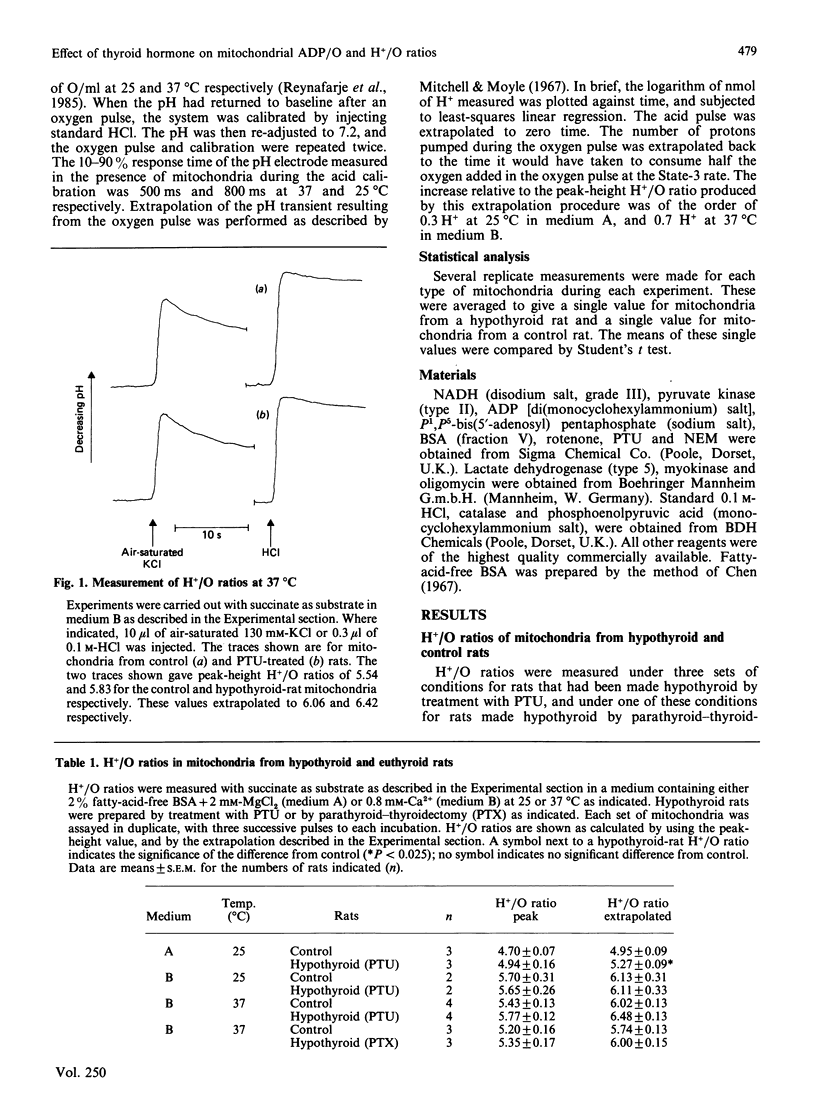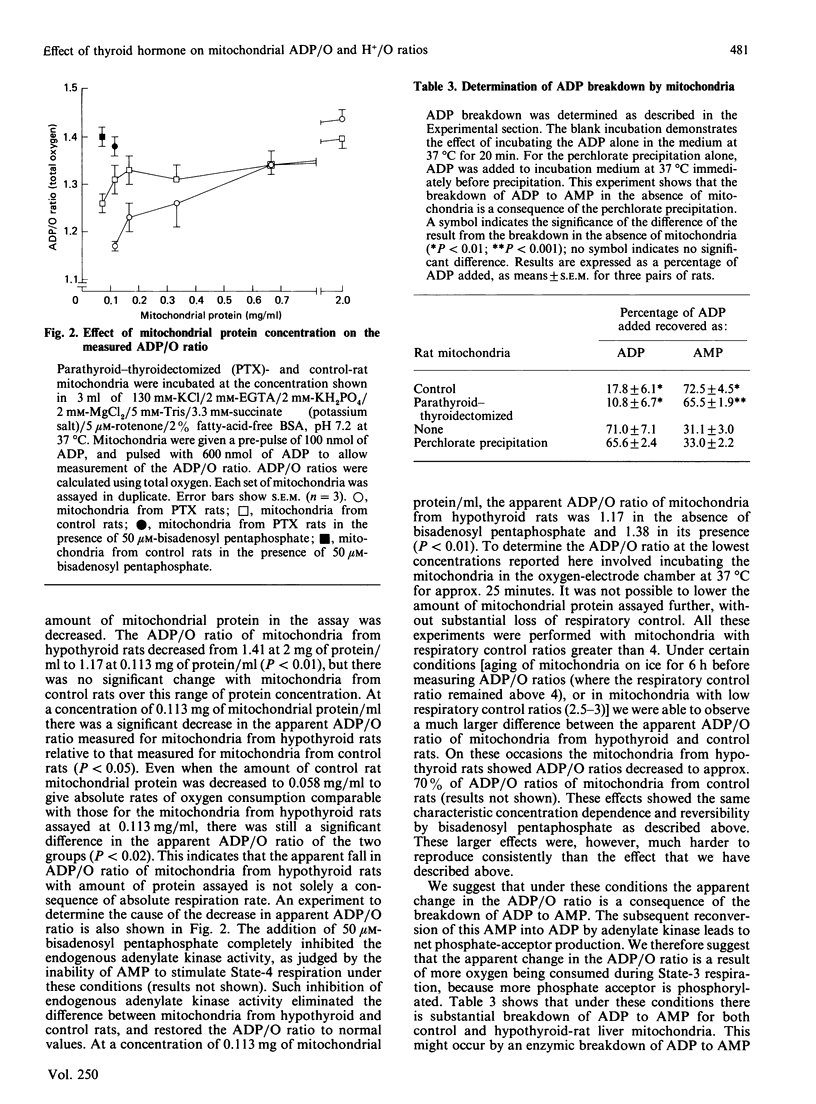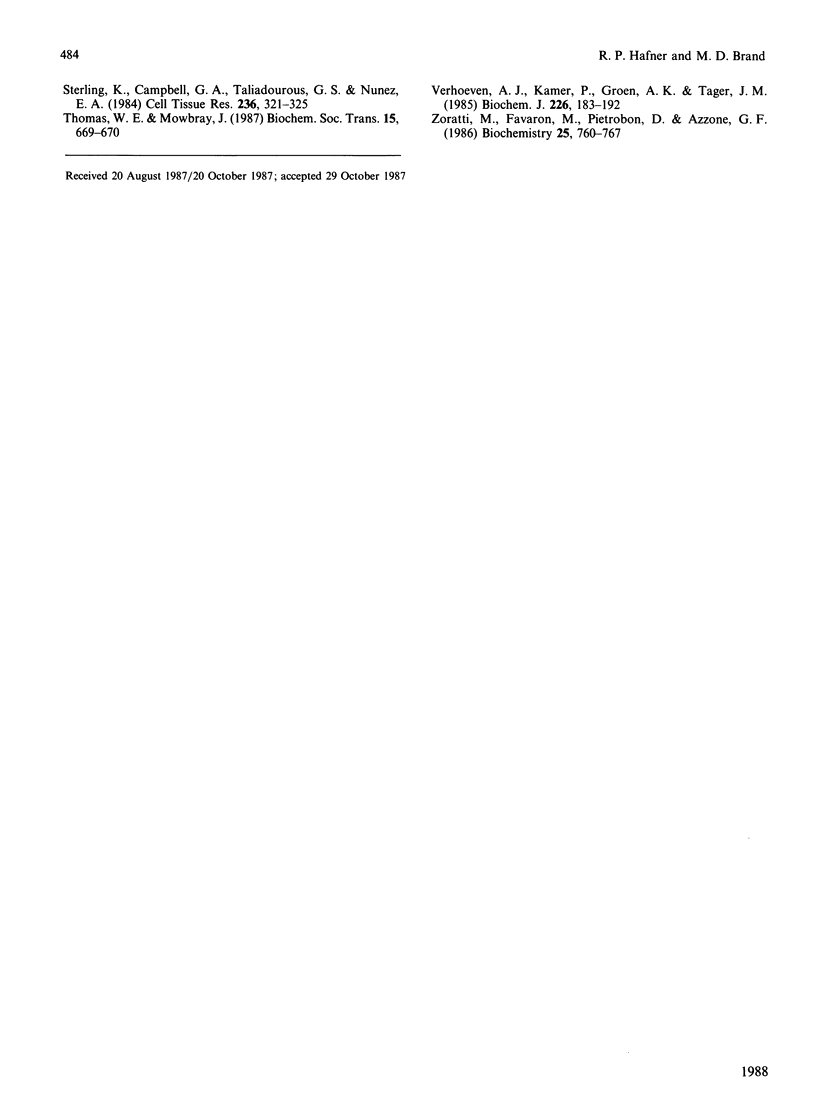Abstract
We investigated reports that mitochondria isolated from hypothyroid rats have decreased ADP/O and H+/O ratios. We observed no decrease in the H+/O ratio in mitochondria from hypothyroid rats, in the presence of either 2% (w/v) fatty-acid-free bovine serum albumin or 100 nM free Ca2+. The ADP/O ratio in mitochondria isolated from hypothyroid rats in the presence of 2% fatty-acid-free bovine serum albumin was measured. Under normal experimental conditions we found no decrease in the ADP/O ratio, relative to that measured for littermate controls. At the low concentrations of mitochondrial protein used in the previously reported studies, the ADP/O ratio of mitochondria from hypothyroid rats was decreased, whereas that for control rats was only slightly decreased. The difference between the ADP/O ratios measured for mitochondria form hypothyroid rats and from control rats under these conditions was eliminated by inhibition of endogenous adenylate kinase. We suggest that the lowering of the apparent ADP/O ratio in mitochondria from hypothyroid rats at low concentrations of mitochondrial protein is an experimental artefact resulting from the breakdown of ADP to AMP.
Full text
PDF







Selected References
These references are in PubMed. This may not be the complete list of references from this article.
- BRONK J. R., BRONK M. S. The influence of thyroxine on oxidative phosphorylation in mitochondria from thyroidectomized rats. J Biol Chem. 1962 Mar;237:897–903. [PubMed] [Google Scholar]
- Brand M. D., Murphy M. P. Control of electron flux through the respiratory chain in mitochondria and cells. Biol Rev Camb Philos Soc. 1987 May;62(2):141–193. doi: 10.1111/j.1469-185x.1987.tb01265.x. [DOI] [PubMed] [Google Scholar]
- Brand M. D., Reynafarje B., Lehninger A. L. Re-evaluation of the H+/site ratio of mitochondrial electron transport with the oxygen pulse technique. J Biol Chem. 1976 Sep 25;251(18):5670–5679. [PubMed] [Google Scholar]
- Brand M. D., Reynafarje B., Lehninger A. L. Stoichiometric relationship between energy-dependent proton ejection and electron transport in mitochondria. Proc Natl Acad Sci U S A. 1976 Feb;73(2):437–441. doi: 10.1073/pnas.73.2.437. [DOI] [PMC free article] [PubMed] [Google Scholar]
- Bronk J. R. Thyroid hormone: effects on electron transport. Science. 1966 Aug 5;153(3736):638–639. doi: 10.1126/science.153.3736.638. [DOI] [PubMed] [Google Scholar]
- Brown G. C., Brand M. D. Changes in permeability to protons and other cations at high proton motive force in rat liver mitochondria. Biochem J. 1986 Feb 15;234(1):75–81. doi: 10.1042/bj2340075. [DOI] [PMC free article] [PubMed] [Google Scholar]
- CHANCE B., WILLIAMS G. R. Respiratory enzymes in oxidative phosphorylation. I. Kinetics of oxygen utilization. J Biol Chem. 1955 Nov;217(1):383–393. [PubMed] [Google Scholar]
- Chen R. F. Removal of fatty acids from serum albumin by charcoal treatment. J Biol Chem. 1967 Jan 25;242(2):173–181. [PubMed] [Google Scholar]
- Crespo-Armas A., Mowbray J. The rapid alteration by tri-iodo-L-thyronine in vivo of both the ADP/O ratio and the apparent H+/O ratio in hypothyroid-rat liver mitochondria. Biochem J. 1987 Feb 1;241(3):657–661. doi: 10.1042/bj2410657. [DOI] [PMC free article] [PubMed] [Google Scholar]
- Ezawa I., Yamamoto M., Kimura S., Ogata E. Alterations of oxidative phosphorylation reactions in mitochondria isolated from hypothyroid rat liver. Eur J Biochem. 1984 May 15;141(1):9–13. doi: 10.1111/j.1432-1033.1984.tb08148.x. [DOI] [PubMed] [Google Scholar]
- Fabiato A., Fabiato F. Calculator programs for computing the composition of the solutions containing multiple metals and ligands used for experiments in skinned muscle cells. J Physiol (Paris) 1979;75(5):463–505. [PubMed] [Google Scholar]
- Greif R. L., Sloane D. Mitochondrial binding sites for triiodothyronine. Endocrinology. 1978 Nov;103(5):1899–1902. doi: 10.1210/endo-103-5-1899. [DOI] [PubMed] [Google Scholar]
- Hashizume K., Ichikawa K. Localization of 3,5,3'-L-triiodothyronine receptor in rat kidney mitochondrial membranes. Biochem Biophys Res Commun. 1982 Jun 15;106(3):920–926. doi: 10.1016/0006-291x(82)91798-3. [DOI] [PubMed] [Google Scholar]
- Hassinen I. E. Mitochondrial respiratory control in the myocardium. Biochim Biophys Acta. 1986;853(2):135–151. doi: 10.1016/0304-4173(86)90008-x. [DOI] [PubMed] [Google Scholar]
- Herd P. A. Thyroid hormone-divalent cation interactions. Effect of thyroid hormone on mitochondrial calcium metabolism. Arch Biochem Biophys. 1978 May;188(1):220–225. doi: 10.1016/0003-9861(78)90375-2. [DOI] [PubMed] [Google Scholar]
- Hinkle P. C., Yu M. L. The phosphorus/oxygen ratio of mitochondrial oxidative phosphorylation. J Biol Chem. 1979 Apr 10;254(7):2450–2455. [PubMed] [Google Scholar]
- Hoch F. L. Early action of injected L-thyroxine on mitochondrial oxidative phosphorylation. Proc Natl Acad Sci U S A. 1967 Aug;58(2):506–512. doi: 10.1073/pnas.58.2.506. [DOI] [PMC free article] [PubMed] [Google Scholar]
- Holness M., Crespo-Armas A., Mowbray J. The influence of thyroid hormone on the degree of control of oxidative phosphorylation exerted by the adenine nucleotide translocator. FEBS Lett. 1984 Nov 19;177(2):231–235. doi: 10.1016/0014-5793(84)81289-2. [DOI] [PubMed] [Google Scholar]
- Lehninger A. L. Proton translocation coupled to mitochondrial electron transport. Biochem Soc Trans. 1984 Jun;12(3):386–388. doi: 10.1042/bst0120386. [DOI] [PubMed] [Google Scholar]
- Mitchell P., Moyle J. Respiration-driven proton translocation in rat liver mitochondria. Biochem J. 1967 Dec;105(3):1147–1162. doi: 10.1042/bj1051147. [DOI] [PMC free article] [PubMed] [Google Scholar]
- Murphy M. P., Brand M. D. Variable stoichiometry of proton pumping by the mitochondrial respiratory chain. Nature. 1987 Sep 10;329(6135):170–172. doi: 10.1038/329170a0. [DOI] [PubMed] [Google Scholar]
- Nicholls D. G. The influence of respiration and ATP hydrolysis on the proton-electrochemical gradient across the inner membrane of rat-liver mitochondria as determined by ion distribution. Eur J Biochem. 1974 Dec 16;50(1):305–315. doi: 10.1111/j.1432-1033.1974.tb03899.x. [DOI] [PubMed] [Google Scholar]
- Nishiki K., Erecińska M., Wilson D. F., Cooper S. Evaluation of oxidative phosphorylation in hearts from euthyroid, hypothyroid, and hyperthyroid rats. Am J Physiol. 1978 Nov;235(5):C212–C219. doi: 10.1152/ajpcell.1978.235.5.C212. [DOI] [PubMed] [Google Scholar]
- Palacios-Romero R., Mowbray J. Evidence for the rapid direct control both in vivo and in vitro of the efficiency of oxidative phosphorylation by 3,5,3'-tri-iodo-L-thyronine in rats. Biochem J. 1979 Dec 15;184(3):527–538. doi: 10.1042/bj1840527. [DOI] [PMC free article] [PubMed] [Google Scholar]
- Papa S., Capitanio N., De Nitto E. Characteristics of the redox-linked proton ejection in beef-heart cytochrome c oxidase reconstituted in liposomes. Eur J Biochem. 1987 May 4;164(3):507–516. doi: 10.1111/j.1432-1033.1987.tb11156.x. [DOI] [PubMed] [Google Scholar]
- Pietrobon D., Azzone G. F., Walz D. Effect of funiculosin and antimycin A on the redox-driven H+-pumps in mitochondria: on the nature of "leaks'. Eur J Biochem. 1981 Jul;117(2):389–394. doi: 10.1111/j.1432-1033.1981.tb06350.x. [DOI] [PubMed] [Google Scholar]
- Pietrobon D., Zoratti M., Azzone G. F. Molecular slipping in redox and ATPase H+ pumps. Biochim Biophys Acta. 1983 May 27;723(2):317–321. doi: 10.1016/0005-2728(83)90131-7. [DOI] [PubMed] [Google Scholar]
- Reynafarje B., Costa L. E., Lehninger A. L. O2 solubility in aqueous media determined by a kinetic method. Anal Biochem. 1985 Mar;145(2):406–418. doi: 10.1016/0003-2697(85)90381-1. [DOI] [PubMed] [Google Scholar]
- Robinson J., Cooper J. M. Method of determining oxygen concentrations in biological media, suitable for calibration of the oxygen electrode. Anal Biochem. 1970 Feb;33(2):390–399. doi: 10.1016/0003-2697(70)90310-6. [DOI] [PubMed] [Google Scholar]
- Samuels H. H., Tsai J. S. Thyroid hormone action in cell culture: domonstration of nuclear receptors in intact cells and isolated nuclei. Proc Natl Acad Sci U S A. 1973 Dec;70(12):3488–3492. doi: 10.1073/pnas.70.12.3488. [DOI] [PMC free article] [PubMed] [Google Scholar]
- Sterling K., Brenner M. A., Sakurada T. Rapid effect of triiodothyronine on the mitochondrial pathway in rat liver in vivo. Science. 1980 Oct 17;210(4467):340–342. doi: 10.1126/science.7423197. [DOI] [PubMed] [Google Scholar]
- Sterling K., Campbell G. A., Taliadouros G. S., Nunez E. A. Mitochondrial binding of triiodothyronine (T3). Demonstration by electron-microscopic radioautography of dispersed liver cells. Cell Tissue Res. 1984;236(2):321–325. doi: 10.1007/BF00214233. [DOI] [PubMed] [Google Scholar]
- Sterling K., Lazarus J. H., Milch P. O., Sakurada T., Brenner M. A. Mitochondrial thyroid hormone receptor: localization and physiological significance. Science. 1978 Sep 22;201(4361):1126–1129. doi: 10.1126/science.210507. [DOI] [PubMed] [Google Scholar]
- Verhoeven A. J., Kamer P., Groen A. K., Tager J. M. Effects of thyroid hormone on mitochondrial oxidative phosphorylation. Biochem J. 1985 Feb 15;226(1):183–192. doi: 10.1042/bj2260183. [DOI] [PMC free article] [PubMed] [Google Scholar]
- Zoratti M., Favaron M., Pietrobon D., Azzone G. F. Intrinsic uncoupling of mitochondrial proton pumps. 1. Non-ohmic conductance cannot account for the nonlinear dependence of static head respiration on delta microH. Biochemistry. 1986 Feb 25;25(4):760–767. doi: 10.1021/bi00352a004. [DOI] [PubMed] [Google Scholar]


